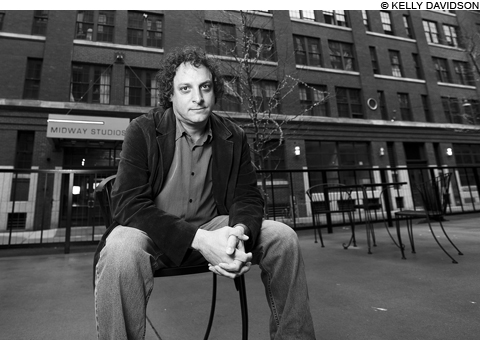
NOWHERE, MAN Artist Nick Ortolino had great hopes for Midway Studios when he first moved in. Now he says
the dream is all but dead.
|
To understand what happens when a defense contractor moves into an artists' enclave and isn't the strangest thing to happen there, one only need look at the saga of Midway Studios.Residents at the Fort Point live-work space have made plenty of headlines for protesting a helmet-assembly plant run by Ops-Core, a subsidiary of global defense giant Gentex. Last week, in a stiflingly hot community meeting, the Boston Redevelopment Authority announced that Ops-Core/Gentex had agreed to move its manufacturing operations out of Midway.
But the incursion of the war industry was just the latest mishap in the development's eight-year history.
"Although it seems like a victory, it's not over yet," said Nick Ortolino, an assistant professor at Wentworth Institute of Technology and one of the first artists to move into Midway. Ortolino still wants to buy his unit, an option promised in the 2004 brochure that drew him and the other original residents to Fort Point. In addition, the brochure touted plans for an eventual art gallery, a theater, and office space for nonprofit arts organizations.
Eight years later, Ortolino's dream of Midway Studios is all but dead. He doesn't own his unit. There is no art gallery. There are no offices for nonprofit arts organizations. Plans to fill the theater with a permanent company or independent cinema never materialized.
The story of Midway Studios begins in the mid '90s, when Fort Point was a shabby haven for those seeking low rents, lofted ceilings, and a community of artists. Then the neighborhood started to change. It was textbook gentrification: developers snapped up old buildings and converted them into high-end apartments and condos, making sure the very people who made the neighborhood appealing to them could no longer afford to live there.
Midway, a joint venture between an artist-geared nonprofit called the Fort Point Development Collaborative and Keen Development, was meant to be Fort Point's cultural touchstone, a glorious reminder of the neighborhood's salad days.
But that didn't happen. In 2010, at the height of the recession, Midway Studios was broke. Its owners applied for refinancing, but as part of the package, the units would remain rentals, and Keen Development would retain exclusive control over the building's commercial space. Over a dozen disappointed residents moved out, and Ops-Core moved in.
FUMING MAD
Though I'd been covering the community meetings for the Phoenix blog, I had no clear understanding of what it looks like when a helmet-assembly plant moves into a building filled with artists.
So one evening last week, Ortolino, a curly-haired man with a Bob Dylan–style hat, brought me to Midway. Joining us was his friend Michael Tyrrell, an energetic architect, installation artist, and former resident.
I peered into the dimly lit ground floor. Framed dramatically in the center of one window was a shiny red motorcycle belonging to Ops-Core founder David Rogers.
In January, while Ops-Core was building its facility, Midway Studios residents began complaining about fumes and noise. In February, an indignant Rogers responded, writing them a letter which reads, in part: